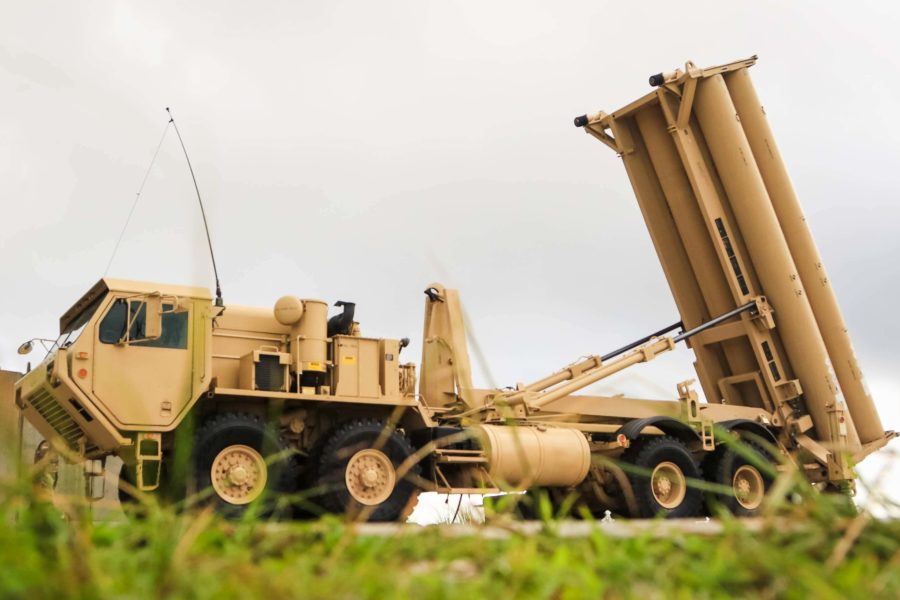Military leaders and analysts are urging the U.S. military to field advanced layered air defense systems to counter China’s growing missile threats to Guam, a crucial hub for U.S. military operations in the Pacific.
“The People’s Republic of China has the ability to mask a number of different threats against a lot of places in the Pacific, including Guam,” Army Brig. Gen. Patrick Costello, head of the 94th Army Air and Missile Defense Command, said at a Center for Strategic and International Studies event on July 30.
Amid China’s expanding military capabilities, one of the greatest current threats to the island is Beijing’s DF-26 intermediate-range ballistic missiles (IRBM), said J. Michael Dahm of the Mitchell Institute for Aerospace Studies. Nicknamed the “Guam killer,” China’s versatile missile can carry both conventional and nuclear warheads and has a maximum range of over 2,000 nautical miles, putting Guam within its reach.
“The missile also has maneuvering capabilities and won’t necessarily follow a ballistic trajectory, which makes it very difficult to engage if you’re shooting at it from the ground,” Dahm told Air & Space Forces Magazine.
The Pentagon estimates Beijing’s arsenal includes around 250 launchers and 500 IRBMs, but Guam’s defenses will also need to brace for a range of land-based threats on top of that.
“Cruise missiles, drones, and other threats coming at the island from much shorter ranges could be launched from ships or bombers,” added Dahm. “So it’s about defeating the DF-26 ballistic missile in conjunction with countering time-synchronized strikes on the island.”
Referred to as “complex integrated attacks,” the layered offense will pose challenges in engaging weapons coming from various speeds, altitudes, and directions simultaneously.
The Pentagon’s $1.7 billion project for the Enhanced Integrated Air and Missile Defense system on Guam aims to deliver “complete, 360-degree protection against ballistic missiles, cruise missiles, and hypersonic threats.” The initiative seeks to add land-based Aegis systems to track and intercept various threats, in addition to the already deployed Patriot and THAAD (Terminal High Altitude Area Defense) systems that are designed to protect against IRBMs.
The Missile Defense Agency’s report from May reveals that a test of the Aegis system is set for December on Guam, launched from Andersen Air Force Base. This will be the island’s first missile test designed to intercept another missile, featuring an interceptor targeting a medium-range ballistic missile that will be air-launched from a C-17 Globemaster or similar aircraft. From there, the island will see up to two live-fire missile tests per year for the next decade. The project integrating THAAD, Patriot, and Aegis systems, is anticipated to become operational by late 2027.
For layered defense against threats like drones and rockets, the Army is currently leading an initiative centered around its Indirect Fire Protection Capability (IFPC), which addresses shorter-range attacks and some cruise missiles.
However, according to the Army’s head of the Program Executive Office for Missiles and Space, the island requires enhanced capabilities to address “a large number of supersonic cruise missiles.” The service is preparing an open competition in Fiscal 2025 to find new interceptors with greater magazine depth.
“Essentially, what I’ve been communicating is an AIM-120D-like capability in an AIM-9X Package,” said Army Brig. Gen. Frank Lozano. The AIM-120D AMRAAM provides greater range and radar-guided precision than the smaller AIM-9 currently used on the IFPC, enabling it to engage targets 50 to 100 miles away with advanced radar. However, directly integrating the AMRAAM system on Guam would still present practical challenges.
“Having six missiles on a launcher and having about a 45 minute reload time—you’re not going to be survivable in a Guam defensive situation,” Lorenzo said of AMRAAMs. The IFPC offers a faster reload time, and each IFPC system could hold 18 AIM-9 interceptors.
Beyond bolstering missile defense, Costello highlighted the importance of making swift and independent decisions within “tactically relevant timelines” in Guam, given its strategic and contested environment. After all, the island is much closer to Beijing than to U.S. Indo-Pacific Command’s headquarters in Hawaii, which its defense system currently falls under.
“To do that, we’re working hand in hand with the Air Force on instituting decentralized command-and-control systems, so that decisions can be made for the defense of the second island chain from the second island chain, and don’t have to come back to Hawaii,” said Costello.
Rules of engagement can become complex due to the tyranny of time, distance, and time zones. Dahm elaborated on that challenge, especially in the context of China. Beijing’s approach to warfare emphasizes controlling information about the battlefield, a concept they refer to as “informationized warfare.”
“Beijing would absolutely try to isolate Guam from the battlespace information network before launching an attack, to make the attack more effective,” said Dahm, which could involve jamming satellite communications, cutting fiber optic cables, or employing cyber-attacks. “Having local control to address threats may be essential when confronting these information-centric attacks.”
Costello said this is particularly crucial not just for Guam but for other Indo-Pacific areas of operations, where close collaboration with regional allies and partners is essential.

